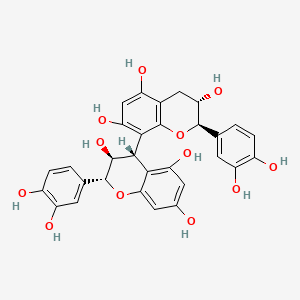
|
Procyanidin B3 |
Procyanidin B3 is a lipid of Polyketides (PK) class. |
55 |

|
(-)-Epigallocatechin gallate |
(-)-Epigallocatechin gallate is a lipid of Polyketides (PK) class. (-)-epigallocatechin gallate is associated with abnormalities such as IMMUNE SUPPRESSION, Infection, Nodule, Lymphopenia and Tumor Immunity. The involved functions are known as Apoptosis, Cellular Immune Response, Specific immune response, Signal and Infiltration. (-)-epigallocatechin gallate often locates in Immune system, Cytoplasmic Granules, Skin, Protoplasm and Body tissue. The associated genes with (-)-Epigallocatechin gallate are C8orf4 gene, Genes, vpr, MAPK8 gene, P4HTM gene and GAG Gene. The related lipids are Promega, Lipopolysaccharides, Palmitates, Fatty Acids and Sphingolipids. The related experimental models are Mouse Model, Xenograft Model, Transgenic Model, Experimental Autoimmune Encephalomyelitis and Arthritis, Collagen-Induced. |
6551 |
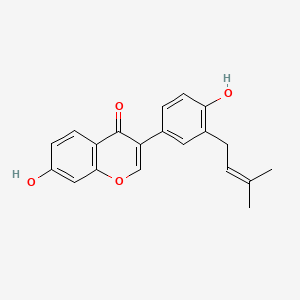
|
Neobavaisoflavone |
Neobavaisoflavone is a lipid of Polyketides (PK) class. |
34 |
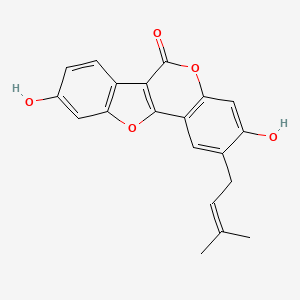
|
Psoralidin |
Psoralidin is a lipid of Polyketides (PK) class. Psoralidin is associated with abnormalities such as Infection, Vitiligo, Psoriasis, Morphologically altered structure and Cyst. The involved functions are known as Signal Transduction, Apoptosis, DNA Binding, Ectopic Expression and kinase activity. Psoralidin often locates in Cytoplasmic matrix, Cytoplasmic, Body tissue, Cytoplasm and Cell membrane. The associated genes with Psoralidin are MSMP gene, BCL2 gene, PDZD2 gene, PKD2 gene and SART3 gene. The related experimental models are Xenograft Model. |
67 |

|
daidzein |
daidzein is a lipid of Polyketides (PK) class. Daidzein is associated with abnormalities such as Cardiovascular Diseases, Osteoporosis, Heart Diseases, Thyroid Diseases and Exanthema. The involved functions are known as Cell Growth, Disease Progression, metaplastic cell transformation, Cell Cycle and M Phase Cell Cycle Arrest. Daidzein often locates in Urothelium, Mucous Membrane, Chromosomes, Epithelium and Ribosomes. The associated genes with daidzein are Tumor Suppressor Genes, Genome, TIRAP gene, TICAM2 gene and Candidate Disease Gene. The related lipids are Promega, Steroids, Saponins, enterodiol and linoleates. The related experimental models are Xenograft Model, Knock-out, Mouse Model, Breast Cancer Model and Arthritis, Experimental. |
4463 |

|
Glycitein |
Glycitein is a lipid of Polyketides (PK) class. Glycitein is associated with abnormalities such as PARAGANGLIOMAS 2, Osteoporosis, Cardiovascular Diseases, PARAGANGLIOMAS 3 and Intestinal Diseases. The involved functions are known as Transcription, Genetic, Regulation, luciferase activity, 5-(carboxyamino)imidazole ribonucleotide mutase activity and Transcriptional Activation. Glycitein often locates in Protoplasm, Cell Nucleus, Body tissue, Membrane and Entire bony skeleton. The associated genes with Glycitein are Genes, Reporter, Genome, Chromatin, JUN gene and G-substrate. The related lipids are Promega, enterodiol, saturated fat and Steroids. |
505 |

|
SCHEMBL62444 |
SCHEMBL62444 is a lipid of Polyketides (PK) class. |
110 |
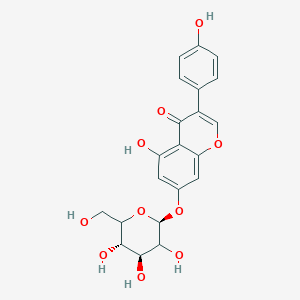
|
genistein 7-O-glucoside |
genistein 7-O-glucoside is a lipid of Polyketides (PK) class. Genistein 7-o-glucoside is associated with abnormalities such as athymia, Heart Diseases, Thyroid Diseases, Plague and Brucella infections. The involved functions are known as Cell Proliferation, Binding (Molecular Function), Ingestion, topoisomerase activity and kinase activity. Genistein 7-o-glucoside often locates in Membrane, Gastrointestinal tract structure, Oral region, Body tissue and Blood. The associated genes with genistein 7-O-glucoside are GLUCOSIDASE, PPP1R1A gene, Homologous Gene, Genome and FUSE gene. The related lipids are Sterols, 1,2-oleoylphosphatidylcholine, Membrane Lipids and DOPE. |
264 |
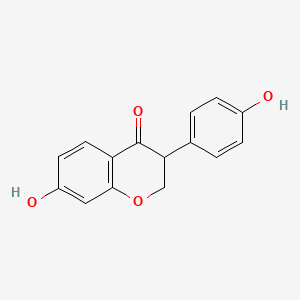
|
dihydrodaidzein |
dihydrodaidzein is a lipid of Polyketides (PK) class. Dihydrodaidzein is associated with abnormalities such as Bacteremia, Little's Disease and Postmenopausal syndrome. The involved functions are known as Metabolic Process, Cellular, racemization, Cytokinesis, enzyme mechanism and Stereochemistry. Dihydrodaidzein often locates in Cell-Free System, Face, Blood, Back and Cytoplasm. The associated genes with dihydrodaidzein are HOXA10 gene and tryptones. The related lipids are enterodiol. |
338 |
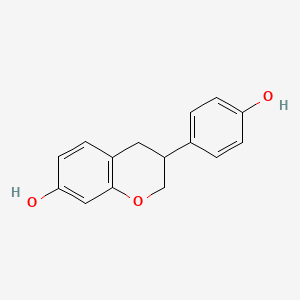
|
94105-90-5 |
94105-90-5 is a lipid of Polyketides (PK) class. 94105-90-5 is associated with abnormalities such as Fish-Eye Disease, Congenital uterine anomaly, Endometriosis, site unspecified, IMMUNE SUPPRESSION and Immune System Diseases. The involved functions are known as Anabolism, Ingestion, Signal Pathways, Phenomenon and Excretory function. 94105-90-5 often locates in brush border membrane, Entire gastrointestinal tract, Mouse Intestine, Body tissue and Skin. The associated genes with 94105-90-5 are GLUCOSIDASE, WASF1 gene, NPRL3 gene, FATE1 gene and AT-Rich Interactive Domain-Containing Protein 1A. The related lipids are butyrate, enterodiol, Steroids, Promega and Fatty Acids. The related experimental models are Mouse Model, Rodent Model, Knock-out, Disease model and Animal Disease Models. |
1223 |









